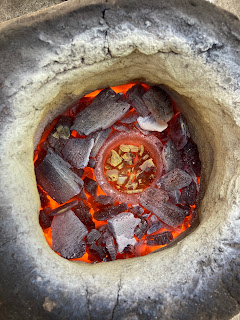Bronze Casting Session No.4
The weather is better so we're back at it with the bronze furnace. I think this is our fourth attempt at casting bronze into our plaster molds. But our poor furnace is on its last legs - that crack goes almost all the way around. Will it survive another firing?
We gathered up pieces of our bronze, almost a kilo's worth, and put the crucible in about halfway. Then we loaded up the furnace with more charcoal.
Our crew was joined this time by our friend Gina who has been wanting to join us for a long time now - most of these photos are hers. So nice to expand the team!
We had a few molds from previous sessions that had never been filled: a pinecone, salamander, a yonilinga, the usual... The furnace got very hot very quickly, and after about 1.5 hours we figured we might be ready.
But once again we were left puzzled by the workings of this most primitive of bronze furnaces. On previous occasions, two hours was more than enough time to melt bronze. This time, we discovered that, while much of the bronze was melted and ready for casting, there were other chunks inside that would not melt.
It's kind of great when you're puzzled; it means you're still learning and you know the feeling of "aha!" awaits you in the future. "The pleasure of finding things out," as Richard Feynman wrote. I think what might have happened here is that some of our bronze was actually brass, or some kind of different alloy with a lower melting point, and that melted fine but the bronze wouldn't. I'm not sure how it got mixed in with the bronze we made, but I don't think there's any other explanation. And besides, we should have been able to melt brass or bronze, as we have in the past.
Maybe this big crack had something to do with it? How much heat escapes from such a hole? My guess is enough to be significant!
We pulled out the box bellows and got the temperature higher, and managed to melt most of it.
To clean the molten bronze of charcoal, we used a metal spoon. This worked well up to a point, except that on hindsight I realize that, by jiggling the spoon over the crucible, I sifted all the crap right back into it!
The other trick we tried was adding Borax. This was very cool. I had no idea how much to use so just added a spoonful. It not only worked well, it was fun to watch.
With these experiences, I think we should have much cleaner metal to pour next time. Here's how it went:
Because some of the metal never melted, we only had enough for a pinecone and a salamander.
The salamander can probably be finished, but the pinecone can go back for remelting - it came out fine but only as good as the original mold (which isn't very good). The furnace survived the whole session, but I think the next entry on this blog will be about us building a new one. It's lasted nine firings over two years. Not bad for clay, mud, broken up brick, and straw! In fact, I'm still in awe of it every time we use it.













As always very cool to read about your advances and challenges.
ReplyDelete